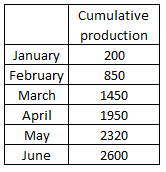1. Refer the below data and table answer the following questions
 How many car were manufactured in the month of April and May ?
How many car were manufactured in the month of April and May ?
Show Similar Question And Answers
 How many car were manufactured in the month of April and May ?
How many car were manufactured in the month of April and May ?  Powered By:Omega Web Solutions
Powered By:Omega Web Solutions